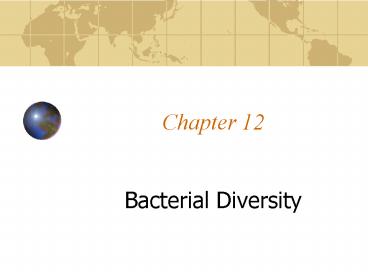Bacterial Diversity - PowerPoint PPT Presentation
1 / 19
Title:
Bacterial Diversity
Description:
... Iron-Oxidizing Bacteria: ex. Thiobacillus, Beggiatoa. Hydrogen-Oxidizing Bacteria: ... Oxidize H2S as an e- donor, but sulfur produced resides outside the cell. ... – PowerPoint PPT presentation
Number of Views:508
Avg rating:3.0/5.0
Title: Bacterial Diversity
1
Chapter 12
- Bacterial Diversity
2
Phylum 1 Proteobacteria
- Gram-negative.
- Show extreme metabolic diversity.
- Represent the majority of known gram-negative
bacteria of medical, industrial, and agricultural
significance. - Ex. Escherichia, Neisseria, Nitrosomonas,
Acetobacter
3
Purple Phototrophic Bacteria
- Ex. Rhodospirillum
- Carry out anoxygenic photosynthesis.
- Contain bacteriochlorophylls and carotenoid
- Include the purple sulfur bacteria, which utilize
H2S as the e- donor for CO2 reduction, and the
purple nonsulfur bacteria, which are actually
able to use sulfide as an e- donor for the
reduction of CO2, but it is toxic at levels
tolerable by the purple sulfur bacteria.
4
Examples of Proteobacteria
- Nitrifying Bacateria Nitrosomonas, Nitrobacter.
- Sulfur- and Iron-Oxidizing Bacteria ex.
Thiobacillus, Beggiatoa - Hydrogen-Oxidizing Bacteria ex. Alcaligenes
- Methanotrophs and Methylotrophs Methylomonas,
Methylobacter - Pseudomonas and the Pseudomonads some are
pathogenic, ex. Pseudomonas aeruginosa UTIs and
URIs.
5
Examples of Proteobacteria (cont.)
- Free-Living Aerobic Nitrogen-Fixing Bacteria
Azotobacter, Azomonas. - Neisseria, Chromobacterium, and Relatives
Neisseria coccobacilli, ex. Neisseria
gonorrhoeae ? gonorrhea. - Enteric Bacteria Escherichia, Salmonella,
Proteus, Enterobacter all are gram-neg.,
nonsporulating rods, nonmotile or motile by
peritrichous flagella, facultative aerobes,
relatively simple nutritional requirements, many
are pathogenic to humans, animals, or plants, or
are of industrial importance.
6
Examples of Proteobacteria (cont.)
- Rickettsias most are obligate intracellular
parasites, cause for ex. spotted fever, typhus, Q
fever. - Gliding Myxobacteria exhibit gliding motility,
some form multicellular fruiting bodies.
7
Phylum 2 Gram-Positive Bacteria
- 2 major phylogenetic subdivisions low GC and
high GC. - Low GC, no endospores ex. Staphylococcus,
Micrococcus, Streptococcus, Lactobacillus - Low GC, endospore-forming ex. Bacillus,
Clostridium (C. botulinum, C. tetani). - Low GC, cell wall-less ex. Mycoplasma.
- High GC ex. Corynebacterium, Propionibacterium,
Mycobacterium - High GC, filamentous Streptomyces ? antibiotics.
8
Phylum 3 Cyanobacteria and Prochlorophytes
- Cyanobacteria Oxygenic phototrophs,
morphologically diverse, contain only chlorophyll
a (green) and phycobilins (blue) thus their
blue-green color. - Some contain gas vesicles or heterocysts.
- Many contain cyanophycin (made of Asp and Arg)
N storage molecule. - Prochlorophytes contain chlorophyll a and b,
but not phycobilins, have a shared common
ancester of green plant chloroplasts and
cyanobacteria.
9
Phylum 4 Chlamydia
- Obligate intracellular parasites.
- Ex. Chlamydia pneumoniae ? respiratory syndromes,
Chlamydia tranchomatis ? STD - Chlamydias are small (1µm they were suspected of
being viruses) and have the simplest biochemical
capacities of all known cellular organisms.
10
Phylum 5 Planctomyces/Pirellula
- Planctomyces stalked bacteria that lack PG
- Have internal compartments for metabolic
functions, etc. that closely resemble those of
the euk. cell.
11
Phylum 6 The Verrucomicrobia
- Form cytoplasmic appendages called prostheca.
12
Phylum 7 The Flavobacteria
- Genera Bacteroides, Flavobacterium.
- Bacteroides Anaerobic, found in the intestinal
tract of humans and other animals and are the
numerically dominant bacteria in the human large
intestine (1010 1011 cells/g of human feces).
Some species are pathogenic and are the most
important anaerobes assoc. with human infections. - Flavobacterium primarily aquatic, rarely
pathogenic.
13
Phylum 8 The Cytophaga Group
- Obligately aerobic.
- Probably account for much of the cellulose
digestion that occurs by prok. in oxic
environments in nature. - Cytophaga spp. some are pathogenic to fish.
- Flexibacter spp. none identified as pathogens.
14
Phylum 9 Green Sulfur Bacteria
- Oxidize H2S as an e- donor, but sulfur produced
resides outside the cell. - Most assimilate a few organic compounds in the
light what is this called? - Autotrophy by reverse citric acid cycle.
- Some form tight 2-membered mutually beneficial
assoc. with a chemoorganotrophic bacterium called
consortia. - Contain various pigments.
15
Phylum 10 The Spirochetes
- Gram neg., motile, tightly coiled.
- Treponema commensals or parasites of humans and
animals, ex. Treponema pallidum ? syphilis. - Leptospira some are parasitic to humans and
animals. - Borrelia most are animal or human pathogens,
ex. Borrelia burgdorferi ? Lyme disease.
16
Phylum 11 Deinococci
- Ex. Deinococcus radiodurans structurally
complex CW, aerobic chemoorganotroph, highly
resistant to radiation (more so than endospores)
and desiccation, have powerful DNA repair
machinery. - Thermus aquaticus thermophilic chemoorganotroph
that produces the Taq polymerase, which is heat
stable and used for PCR.
17
Phylum 12 The Green Nonsulfur Bacteria
- Ex. Chloroflexus filamentous, form thick
microbial mats in neutral to alkaline hot
springs, may have first evolved a photosynthetic
rxn. Center, is the most phylogenetically ancient
of anoxygenic phototrophs. - Some have interesting membrane lipids and lack PG.
18
Phylum 13 and 14 Deeply Branching
Hyperthermophilic Bacteria
- Hyperthermophiles (optimal growth at temps. above
80C). - Ex. Thermodesulfobacterium most thermophilic of
all sulfate-reducing Bacteria, contain
ether-linked lipids. - Ex. Aquifex most thermophilic of all known
Bacteria. (grow up to 95C, optimum 85C).
19
Phylum 15 and 16 Nitrospira and Deferribacter
- Not much is known about these phyla they have
been identified by rRNA sequencing and are either
chemolithotrophs or chemoorganotrophs and are
mesophiles to thermophiles. - Some Nitrospira ox. nitrite to nitrate.































